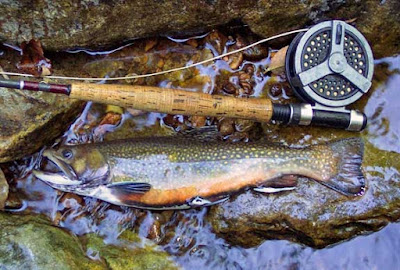Trout is the common name that is given to a number of species of freshwater fish belonging to the salmon family, Salmonidae. All fish that are properly called trout are members of the subfamily Salmoninae, but the name is used for fish from all three genera in the sub-family: Salmo, which includes Atlantic species; Oncorhynchus, which includes Pacific species; and Salvelinus, which includes fish referred to as char or charr including brook trout. Brook trout fishing requires an excellent knowledge of the trout nature and the environment it lives in so you can be successful in your fishing.
Brook trout are one of the tastiest trout to eat and can mainly be found in cold moving water throughout the Rocky Mountains including creeks, lakes, rivers and streams. They prefer medium to fast flowing water that is on the cool side with in the range of 57 to 60 degrees Fahrenheit as well as water that contains lots of oxygen like spring fed streams and pools. During the spawn they can be found in clean shallow pools that contain lots of gravel on the bottom. They are described as being stationary and can also be found under the cover of logs, rocks and undercut banks. The larger, older brook trout commonly inhabit the deeper pools and move to the shallow water in order to feed.
Since brook trout, also known as brookies, mostly live in colder water, they are slow moving and have a life span of up to about eight years. One of the identifying characteristics of the brook trout is their long, streamlined body and large mouth which extends past their eyes. Their body color can vary slightly and includes blue-gray, olive or black above and their bellies are typically silvery white. Brook trout also have striking red dots with blue halos making them one of the easier fish to identify. Although, the biggest tell tale markers used to identify brook trout are the spotted dorsal fin and worm like marking along its back referred to as vermiculations. In general their tail fins are square but some rare specimens have been seen with a slightly forked tail fin. They can also easily be identified by looking at their lower fins that have a white front edge and black with the rest of the fin being reddish orange. The male brook trout can appear as very bright orange-red along their sides during fall which is their breeding time.
The key to successful fresh water fishing is to walk slowly and steadily and avoid making a lot of splashing motions because this can scare away the fishes. Wade in the center of the creek and then cast your line towards the bank. Do not worry if the water is a little shallow, brook trout will amaze you as to the places that they can hide. Although you are able to gain access to more places if you wade in the water, it is possible to fish from the bank. With either place you choose to fish from, just make sure that you are seeing the bottom so you know just how deep the water is. Brook trout are voracious feeders and have the potential to consume a large number of different bait such us crustaceans, fishes, worms, terrestrial insects, zooplankton and aquatic insects. You can use various lures and baits in brook trout fishing including wet and dry flies, crickets, worms, grasshoppers, spoons and spinners.

No comments:
Post a Comment